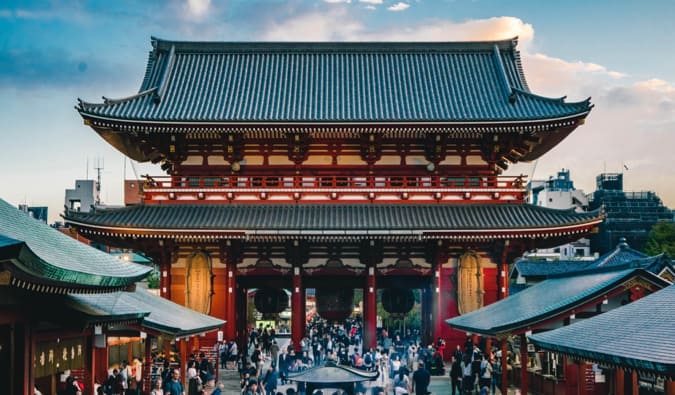 Posted
Posted: 11/23/2019 | November 23rd, 2019
Tokyo is an incredible, massive city home to over 10 million people. It’s the capital of
Japan and home to a wide array of fun, historic, and quirky attractions. From the world’s largest tuna auction and the Imperial Palace to robot restaurants and vampire cafés, Tokyo really does have something for everyone.
Whether you’re here for a short stopover or living here as an expat, you’ll be able to find plenty of ways to pass the time and get a feel for the organized chaos that is Tokyo. To help you make the most out of your trip, here are the best things to see and do in Tokyo:
1. Visit the Fish Market

The Tsukiji Fish Market was one of the most iconic staples of the city. In 2018, the market moved to Toyosu and is now twice the size of the original Tsukiji market. In fact, the new market is the largest fish market in the entire world. While you’ll need a visitor’s pass to enter (you can get one on arrival) the pass is free (which means you’ll have more money to spend on sushi!)
There are over 600 vendors here selling fresh fish as well as fresh fruits and vegetables. Gorge on sushi and marvel at the chaotic atmosphere of the world’s largest tuna market. The tuna auction here powers much of the world’s sushi supply, and it is truly a sight to be seen. You can also see a model of the largest tuna ever sold at Tsujiki — which weighed 500kg (1,100lbs!).
In addition to the new market, the old outer market at Tsukiji still has plenty of restaurants and shops. You can still head there to eat and look around, though all the action is now at Toyosu. Be sure to arrive early to beat the crowds (especially on Saturdays).
Tsukiji Fish Market: 5 Chome-2-1 Tsukiji, Chuo, +81 3-3542-1111. Admission is free. Toyosu Fish Market: 6 Chome-6-2 Toyosu, Koto, +81 3-3520-8205. Open Monday-Saturday from 5am-5pm, though most shops don’t open until 7am. Admission is free.
2. Explore by the Imperial Palace
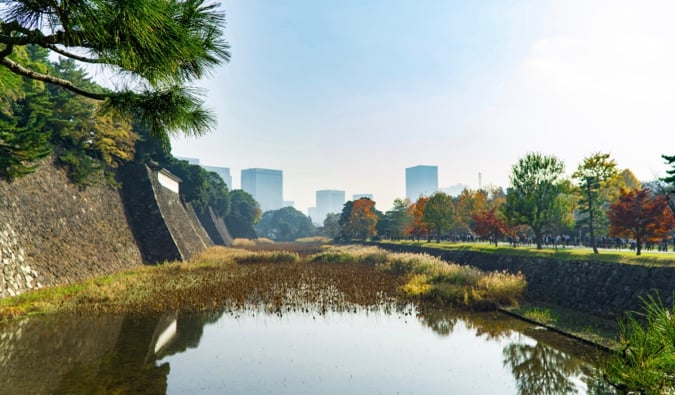
The Imperial Palace is the official home of the Emperor of Japan. It’s a terrific spot to learn about Japan’s history and culture. Formerly Edo Castle, the palace was built in the 15th century, and some of the walls and moats from that time are still in use to this day. When the Emperor moved from
Kyoto to Tokyo in 1869, he took Edo for his new palace and renamed it the Imperial Palace.
You can’t go inside (or even get super close), however, the building itself is both regal and serene and a great place to relax or snap some photos. The palace is surrounded by beautiful grounds and a park, and there’s a moat around the massive stone walls. Admission to the grounds is free.
3. Experience a Tea Ceremony
No visit to Japan is complete without experiencing a traditional tea ceremony. Tea was brought to Japan in the 9th century by a Buddhist monk and by the 12th century, the ceremony began to take shape. While these ceremonies are usually long (not to mention expensive), there are plenty of budget-friendly options for anyone looking to experience one without breaking the bank. Here are a few budget-friednly tea ceremonies in Tokyo worth checking out:
- Kyoto-kan (500 JPY per person, Yanmar Tokyo Building 1F 2-1-1)
- Nadeshiko (2,700-4,400 JPY per person, 2-7-24-2F Asakusa)
- The Way of Tea (5,500 JPY per person, Coredo Muromachi 3 3F)
4. Relax in Ueno Park
Ueno Park is a relaxing and beautiful spot to relax for a few hours (or an entire day if you’re not in a rush). It’s a serene spot to photograph the many cherry trees that line the park (which blossom in April and are a huge tourist draw) or to have a picnic on a sunny summer afternoon.
There are also a few important things to see in the park as well. Here are a few sights in the park you should make time to visit:
- Tokyo National Museum – Established in 1872, this museum is located in the north end of the park and houses one of the world’s largest collections of art and artifacts from Asia, particularly Japan. 13-9 Uenokoen, Taito, +81 3-3822-1111, tnm.jp. Open daily 9:30am-5pm (8pm on most Fridays). Admission is 620 JPY.
- Tosho-gu Shrine – This is a 17th-century Shinto shrine with stunning gold doors and ornate carvings. 9-88 Uenokoen, Taito, +81 3-3822-3455, uenotoshogu.com/en. Open daily 9am-5:30pm. Admission is free, though to go further into the shrine, you’ll have to pay 500 JPY.
- National Museum of Western Art – Opened in 1959, this is one of the only art galleries in the country to focus on Western art. The collection is comprised of 5,000 pieces, dating from the Renaissance all the way to the 20th century. There are works by Van Gogh, Monet, Renoir, and Picasso as well as sculptures dating back to the 14th century.7-7 Uenokoen, +81 3-3828-5131 , nmwa.go.jp. Open Tuesday-Sunday 9:30am-5:30pm (8pm on Fridays). Admission is 500 JPY for adults, 250 for college students, and free for seniors and anyone under 18.
5. Eat at the Robot Restaurant

This restaurant, literally called Robot Restaurant, is an absolute sensory overload. it has lasers, robots, monsters, music, dancing and much, much more! Sure, it may be a bit of a tourist trap (aka it’s not cheap), but it is an epic dining experience unlike anything you’ve ever seen. It’s definitely worth the price if you want to do something completely out of the ordinary — and something decidedly Japanese.
1 Chome-7-1 Kabukicho, +81 3-3200-5500, shinjuku-robot.com/pc. There are three performances a day on weekdays starting at 4:45pm, with afternoon matinees on weekends.
6. Tokyo Metropolitan Teien Art Museum
This small museum used to be the official residence of the Prince and Princess Asaka. Built in 1933, the building itself was influenced by the art deco movement in Paris. The prince had studied in Paris and wanted to bring the art deco style to Japan, hence the building’s style and decorations. In 1983, the residence transitioned into a museum and is now home to a rotating series of modern art exhibitions. See their website for information on what exhibits are available.
5-21-9 Shirokanedai, +81 3-3443-0201, teien-art-museum.ne.jp/en. Open daily 10am-6pm. Admission is 200 JPY, with discounts available for students, children, and seniors.
7. Stroll Along the Meguro River
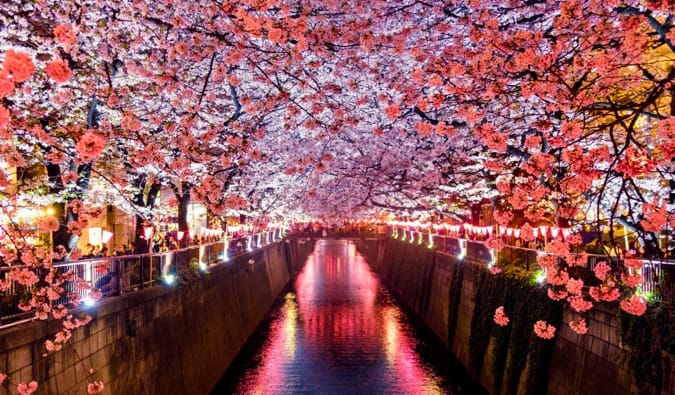
The Meguro River weaves almost five miles through the city and makes for a magnificent stroll. There’s a path with a bit of green space that follows the water, so plenty of locals walk or exercise there. In the spring, you’ll be able to see a lot of cherry blossoms as you walk along the banks of the river as well.
While the walk is nice at any time of year, late March to early April is when the cherry blossoms will be in bloom. While there will be a lot of people then (cherry blossom viewing is a national pastime) you’ll be rewarded with some beautiful scenery in the heart of the metropolis.
8. Check out Asakusa
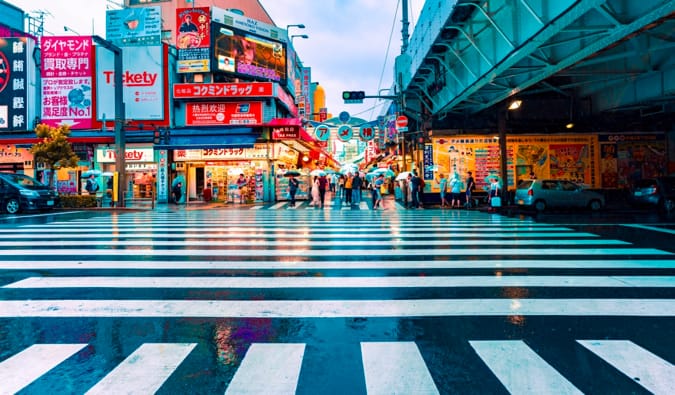
If you want to check out some of Tokyo’s historic and culturally-significant religious sites, be sure to spend some time wandering around Asakusa. Two places that I’d suggest you visit are:
- Senso-ji – This is Tokyo’s most popular (and arguably most famous) temple. It’s beautifully painted and sits in a scenic spot near a pagoda and the Kaminari Gate. There’s a huge statue of Kannon, the goddess of mercy, inside the main hall. It’s busy during the day so aim to visit in the evening to beat the crowds. 2 Chome-3-1 Asakusa, Taito, +81 3-3842-0181, senso-ji.jp. The grounds are open 24/7, though the temple itself is open daily 6am-5pm. Admission is free.
- Asakusa Shrine – This is a Shinto shrine located near Senso-ji. It’s much more peaceful and less busy than Senso-ji as well. It was built during the Edo period and miraculously survived the air raids of World War II. 2 Chome-3-1 Asakusa, Taito, +81 3-3844-1575, asakusajinja.jp. Open daily 9am-4:30pm. Admission is free.
9. Have Dinner with Ninjas
For another unique dining experience, head to Ninja Akasaka. It’s a novelty ninja-themed restaurant designed like an Edo-era building. The waitstaff are clothed in stereotypical all-black garb and trained in all sorts of simple tricks, sleight of hand, and illusions. You’ll order off old scrolls while being entertained by the skillful tricks of your server. The food isn’t anything special it’s super fun and the atmosphere is unique.
Tokyu Plaza Akasaka, +81 3-5157-3936, ninjaakasaka.com. Open daily 5pm-10:30pm (9:45pm on Sundays)
10. Drink in Golden Gai

If you are looking for something interesting to do at night, this alley of backstreet bars is a cool spot to start at. There isn’t much going on here during the day, but come sundown, these zigzag hallways and closet-sized beer rooms are filled with interesting people and cheap drinks. There are 6 alleys connected by narrow passageways only wide enough for 1 or 2 people, making it a rather unique place to start your night out on the town. It’s located in Shinjuku.
11. Visit the National Art Center
Opened in 2007, this museum and gallery doesn’t actually have a permanent collection but rather houses a never-ending series of temporary exhibitions, from impressionism to modern art (the Monet exhibition that was held here in 2007 was the most visited exhibition in the world). There are upwars ofr 60+ exhibitons each year so check their website to see what is currently being shown.
7 Chome-22-2 Roppongi, +81 3-5777-8600, nact.jp. Open Wednesday-Monday 10am-5:30pm. Admission varies by exhibit.
12. Eat Below the Girders
Not far from Ginza is the Yurakucho neighborhood. Below the elevated train tracks at Yurakucho Station is a 700m-long stretch of restaurants and bars. There are wine bars, beer pubs, and casual restaurants filled with businessmen. If you want to get a sense of local city life, this is a good neighborhood to explore after the workday is over.
13. Superhero Go-Karting

If you’re a video game fan (or just want to do something different), check out Street Kart. This is a real-life Mario Bros. go-kart company that lets you dress up and race around the city. As long as you have an international driving permit (which you can get if you have a valid driver’s license), you can take part, racing around the city dressed up as Mario, Yoshi, or even Spiderman.
4-12-9 Sotokanda, +81 80-8899-8899, maricar.com/en/akihabara.html. Open daily 10am-10pm. The course will take 1-2 hours and costs 9,000 JPY per person. There are multiple locations around the city.
14. Check out a Sento
A
sento is a traditional (and communal) Japanese public bathhouse. In the past, private baths were rare as accommodations in Japan are notoriously small. While private baths are much more commo today, sentos remaining important cultural hubs. The Japanese are not shy in sentos so you need to be comfortable with nudity! They are typically separated by gender. A budget-friendly sento will cost you just under 1,000 JPY. Just keep in mind that many have rules against tattoos.
15. Visit a Quirky Café

Tokyo has all sorts of weird and wonderful cafés. Monster cafés, cat cafés, dog cafés, owl cafés, vampire cafés, and much more! If you can think of it, there is probably a café for it somewhere in the city. If you’re looking for something unusual to do (or just want a place to relax after exploring) then take a look and see what weird and quirky cafés are near you (they’re all around the city so you never have to go far to find one!).
Here are some suggestions to help you get started:
- Kawaii Monster Café
- Vampire Café
- Christon Café (Christian-themed café)
- Dog Heart (dog café)
- Cat Café Calico
16. See Shibuya Crossing
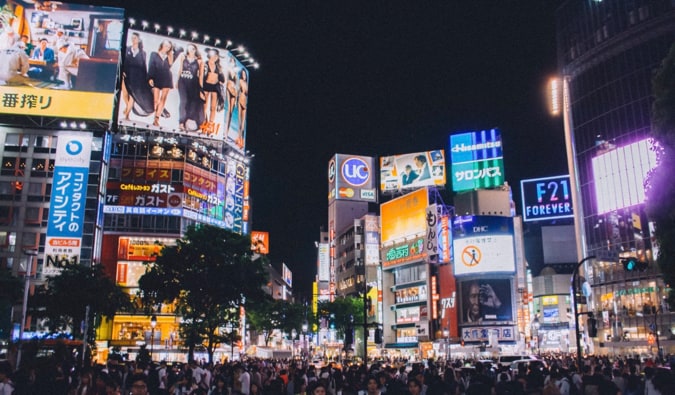
This is generally considered to be the busiest (and most famous) intersection in the world. This nearby metro station transports 2.4 million people per day and it’s estimated that upwards of 2,500 cross it at a time during rush hour. At night, the interaction is buzzing. Futuristic bright lights line the streets, with billboards playing videos and ads. It has a sci-fi feel to it (it kind of reminds me of Times Square on steroids).
While you’re here, make sure to visit the statue between Shibuya Station and the intersection. It’s a tribute to Hachiko, a loyal dog who waited for its master every day for 9 years, not knowing his owner had passed away. The dog is something of a national icon in Japan, and the story was made famous by the film
Hachi: A Dog’s Tale.
17. Stroll Around Shimokitazawa
Brimming with vintage shops, this Bohemian neighborhood is often compared to New York’s East Village. It’s a great example of the quieter side of Tokyo and offers some more relaxing streets to wander and window shop. Whether you’re looking to shop or just want to take in the scene, this is a cool neighborhood to explore for a couple hours.
18. Gaze at Mt. Fuji from Hakone
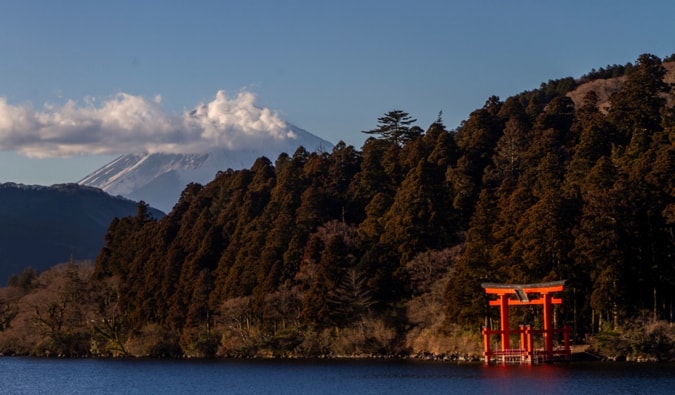
If you want to take a day trip (or a multi-day trip) from the city, consider going to Hakone. It’s located just over an hour from Tokyo and is one of the best places to get away from the city, relax for a few days, and take in the view of Mount Fuji. There are numerous guesthouses in the area, many with their own private
onsen (natural hot springs), making it a great place to go for a romantic getaway or if you just want to pamper your yourself.
If you have the Japan Rail Pass you can get here for free.
19. Hang with the Harajuku Girls
Harajuku is an electric and quirky part of town known for its fashion, vintage stores, and cosplay shops. As you wander, you’ll often see “Harajuku girls” walking around town in unique clothing and colorful hairstyles (imagine a 1990s Gwen Stefani video come to life). In addition to all of the avant-garde fashion, there are also tons of trendy restaurants in the area as well. And there is also a monthly Harajuku Fashion Walk which highlights the costumed cos-players of the city as they parade around. For specific dates, check out the group’s Twitter account (@harajuku_fw).
20. Watch a Sumo Match

Kokugikan is Japan’s most famous sumo wrestling arena. It hosts tournaments three times each year, all of which draw huge crowds. Sumo wrestling (the kind we are familiar with today) dates back to the 17th century, though its origins date back even further. Even to this day, it’s still one of the most popular traditions in the country. If you’re in town at the right time, this is a must-do (even if you’re not a sports fan, it’s a unique and rare opportunity). Tickets sell out quickly so be sure to book early.
1 Chome-3-2-8 Yokoami, Sumida, +81 3-3623-5111, sumo.or.jp/kokugikan. Ticket prices vary, but expect to pay around 2,200 JPY.
21. Watch Traditional Japanese Theatre
Kabuki theatre is a traditional form of Japanese performance involving dance and drama. The costumes and makeup are heavily stylized, making for a very visual performance. The Kabukizaka Theatre, located in Ginza, is the best place to see these incredible and power performances. You can purchase tickets for an entire show or just one act if you’re not ready to commit to a longer performance (they’re in Japanese and usually last a few hours).
4 Chome-12-15 Ginza, +81 3-3545-6800, kabuki-za.co.jp. Performances are held almost daily. Check the website for the most up-to-date schedule. Expect to pay at least 1,000 JPY for a single-act ticket.
22. Visit Daibutsu (the Great Buddha)
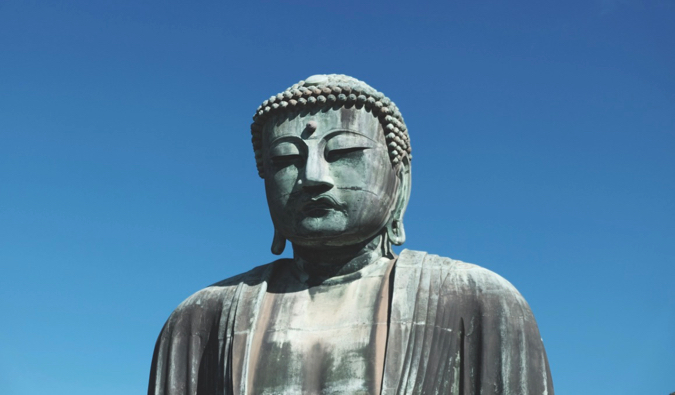
For another day trip, head to Kamakura. Here you’ll find a 13m bronze statue of Buddha that was built in 1252. The statue was initially constructed within a temple, but the temple was washed away — on several occasions — by storms.
Today, the statue now sits in the open air (along with a massive pair of straw sandals that belong to the statue). You can even go inside the statue itself (there isn’t much to see, but it’s still kind of neat to be able to step into a massive statue of that size and importance). The journey only takes about an hour so it’s a great destination for a half-day or full-day excursion.
4 Chome-2-28 Hase, Kamakura, +81 467-22-0703, kotoku-in.jp. Open daily 8am-5:30pm. Admission is 200 JPY. If you have the Japan Rail Pass you can get here for free.
23. Visit the Ghibli Museum
If you’re a fan of the award-winning director Hayao Miyazaki’s work (he’s the genius behind Spirited Away, Howl’s Moving Castle, and Princess Mononoke), then you’ll want to check out this amazing museum. The exhibition was actually designed by Miyazaki himself and is an immersive experience that any film buff will appreciate. The museum hosts a new short film every month, only available to visitors. While a visit here won’t take up a whole day, it’s not in a very central location so you’ll need to plan accordingly (it’s about an hour from downtown Tokyo).
1 Chome-1-83 Shimorenjaku, +81 570-055-777, ghibli-museum.jp. Open Wednesday-Monday 10am-6pm. Admission is 1,900 JPY for adults, with discounts available for youth and children. There are limited tickets available each day so book in advance.
24. Get Touristy at Tokyo Disneyland

I’m a sucker for Disney attractions! This is a fun choice for anyone traveling with children, but also for any adults who just love amusement parks. Opened in 1983, it has seven themed areas to explore and is the third most visited theme park in the world. it has a lot of the same famous rides you’ll find at Disney World such as Splash Mountain, The Haunted Mansion, and the nauseating Mad Tea Cup Ride.
1-1 Maihama, Urayasu, +81 45-330-5211, tokyodisneyresort.jp/tdl. Open daily 8am-10pm. Admission is 7,400 JPY for adults and 4,800-6,400 JPY for children, depending on age.
25. Hike Mount Mitake
Located just over an hour from Tokyo is Chichibu-Tama-Kai National Park. The park covers 1,250 square kilometers of rolling hills, mountains, and lush forests. There are plenty of hiking trails, though you can also take a cable car to the top and then hike to the shrine that sits on the peak, some 930m above sea level. It’s a 30-minute walk to the shrine from the peak/top of the cable car. From there, you can hike for an hour to a small valley with two picturesque waterfalls or continue on to Mount Otake, which is about 2 hours from the summit of Mount Mitake.
26. Stroll through Shinjuku Gyoen National Garden
This park spans over 144 acres and is home to some 20,000 trees. Most of the original park was destroyed in World War II, however, it was rebuilt and reopened in 1949. During spring, the park is one of the best spaces to see cherry blossoms. My favorite part is the Japanese landscape garden, which has several ponds with bridges and islands. It’s a peaceful little oasis within the hustle and bustle of the city.
11 Naitomachi, Shinjuku, +81 3-3350-0151, env.go.jp/garden/shinjukugyoen/index.html. Open Tuesday-Sunday 9am-4pm. Admission is 200 JPY.
27. Visit the Tokyo Tower
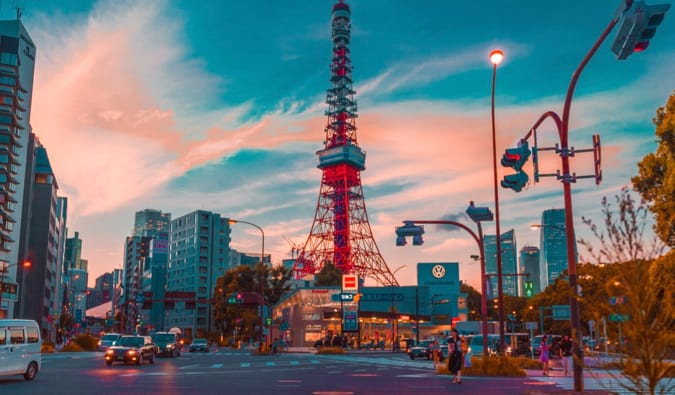
Built in 1957, Tokyo Tower resembles the Eiffel Tower (though the Tokyo Tower is taller, standing 333m). It’s made entirely of steel and you can pay to go all the way to the top floor to take in the view. While the views are amazing, the main observation deck offers one that’s just as good for almost half the price.
4 Chome-2-8 Shibakoen, Minato, +81 3-3433-5111, tokyotower.co.jp. Open daily 9am-11pm. Admission is 900 JPY for the main deck or 1,600 JPY for the top.
28. Visit the Samurai Museum
No trip to
Japan would be complete without learning about samurai. While they were known for their skills in combat, there was much more to the culture than just mastering the sword. This museum does a great job of illuminating life as a samurai and it also has some incredible displays of traditional weapons and armor (some of which you can even try on)
Kabukicho 2-25-6, +81 3-6457-6411, samuraimuseum.jp/en. Open daily 10:30am-9pm. Admission is 1,900 JPY per person. You can explore the museum on your own or in a group tour, which are conducted every 30 minutes.
29. Walk across the Rainbow Bridge
This is the city’s most popular bridge and offers some lovely views of both sides of Tokyo Bay. Built in 1993, the bright lights up at night with rainbow colors — hence the name. It makes for a pleasant walk during the day or at night if you need to stretch your legs after binging on sushi.
30. Drinks at the Park Hyatt

New York Bar is the iconic bar from Sofia Coppola’s 2003 film Lost in Translation. Located on the 52nd floor, the bar actually lives up to the hype of the film. The atmosphere is classy, the drinks are great, and the view is absolutely stunning. There is live jazz every night, and while there is a cover charge (around 2,500 JPY), it’s definitely worth it if you’re looking to splash out.
3-7-1-2 Nishishinjuku, +81 3-5322-1234, hyatt.com. Open Sunday-Wednesday 5pm-12am and Thursday-Saturday 5pm-1am.
***
Tokyo is one of those cities that really does have something for everyone. Nightlife, delicious food, accessible nature, insightful museums, art galleries, relaxing parks — you name it, you can find it here. But where the city really shines is with its quirky offerings. You’ll find tons of weird and wonderful restaurants, cafés, and activities here — things you wont find anywhere else in the world.
While the city isn’t the cheapest in Asia (
though there are lots of ways to save money here it offers visitors the opportunity to experience life in one of the most electric, futuristic cities in the world. And, to me, that’s worth the price.
Book Your Trip to Japan: Logistical Tips and Tricks
Book Your Flight
Find a cheap flight by using
Skyscanner or
Momondo. They are my two favorite search engines because they search websites and airlines around the globe so you always know no stone is left unturned.
Book Your Accommodation
You can book your hostel with
Hostelworld as they have the most comprehensive hostel inventory out there. If you want to stay in a hotel or guesthouse, use
Booking.com as they consistently return the cheapest rates. My favorite places to stay in Tokyo are:
- Khaosan Tokyo Kabuki – This is one of the best hostels in the country. The staff go above and beyond, each room has its own bathroom, and it’s in a great location to help you explore the city.
- Sheena and Ippei – This hostel is super homey, and the owners are both helpful and knowledgable. The lounge is open to everyone, and you can enjoy appetizers and sake on the weekends.
- Hostel Chapter Two Tokyo – This is a small, family-run hostel in Asakusa. There’s a great view of the river and the dorms seem new and immaculately clean.
Don’t Forget Travel Insurance
Travel insurance will protect you against illness, injury, theft, and cancellations. It’s comprehensive protection in case anything goes wrong. I never go on a trip without it as I’ve had to use it many times in the past. I’ve been using
World Nomads for ten years. My favorite companies that offer the best service and value are:
Looking for the best companies to save money with?
Check out my
resource page for the best companies to use when you travel! I list all the ones I use to save money when I travel – and I think will help you too!
Looking for more travel tips for Japan
Check out my in-depth
Japan travel guide for more ways to save money, costs, tips on what to see and do, suggested itineraries, reading, packing lists, and much, much more!
Photo credit:
1 – AlexTalmaciu,
4 – Nick Turner,
5 – shiranai,
6 – Liz Mc,
9 – Michael Mortola,
12- Ian Kennedy,
16 – HeatherLWilliams
 Posted: 11/23/2019 | November 23rd, 2019
Tokyo is an incredible, massive city home to over 10 million people. It’s the capital of Japan and home to a wide array of fun, historic, and quirky attractions. From the world’s largest tuna auction and the Imperial Palace to robot restaurants and vampire cafés, Tokyo really does have something for everyone.
Whether you’re here for a short stopover or living here as an expat, you’ll be able to find plenty of ways to pass the time and get a feel for the organized chaos that is Tokyo. To help you make the most out of your trip, here are the best things to see and do in Tokyo:
Posted: 11/23/2019 | November 23rd, 2019
Tokyo is an incredible, massive city home to over 10 million people. It’s the capital of Japan and home to a wide array of fun, historic, and quirky attractions. From the world’s largest tuna auction and the Imperial Palace to robot restaurants and vampire cafés, Tokyo really does have something for everyone.
Whether you’re here for a short stopover or living here as an expat, you’ll be able to find plenty of ways to pass the time and get a feel for the organized chaos that is Tokyo. To help you make the most out of your trip, here are the best things to see and do in Tokyo:
 The Tsukiji Fish Market was one of the most iconic staples of the city. In 2018, the market moved to Toyosu and is now twice the size of the original Tsukiji market. In fact, the new market is the largest fish market in the entire world. While you’ll need a visitor’s pass to enter (you can get one on arrival) the pass is free (which means you’ll have more money to spend on sushi!)
There are over 600 vendors here selling fresh fish as well as fresh fruits and vegetables. Gorge on sushi and marvel at the chaotic atmosphere of the world’s largest tuna market. The tuna auction here powers much of the world’s sushi supply, and it is truly a sight to be seen. You can also see a model of the largest tuna ever sold at Tsujiki — which weighed 500kg (1,100lbs!).
In addition to the new market, the old outer market at Tsukiji still has plenty of restaurants and shops. You can still head there to eat and look around, though all the action is now at Toyosu. Be sure to arrive early to beat the crowds (especially on Saturdays).
Tsukiji Fish Market: 5 Chome-2-1 Tsukiji, Chuo, +81 3-3542-1111. Admission is free. Toyosu Fish Market: 6 Chome-6-2 Toyosu, Koto, +81 3-3520-8205. Open Monday-Saturday from 5am-5pm, though most shops don’t open until 7am. Admission is free.
The Tsukiji Fish Market was one of the most iconic staples of the city. In 2018, the market moved to Toyosu and is now twice the size of the original Tsukiji market. In fact, the new market is the largest fish market in the entire world. While you’ll need a visitor’s pass to enter (you can get one on arrival) the pass is free (which means you’ll have more money to spend on sushi!)
There are over 600 vendors here selling fresh fish as well as fresh fruits and vegetables. Gorge on sushi and marvel at the chaotic atmosphere of the world’s largest tuna market. The tuna auction here powers much of the world’s sushi supply, and it is truly a sight to be seen. You can also see a model of the largest tuna ever sold at Tsujiki — which weighed 500kg (1,100lbs!).
In addition to the new market, the old outer market at Tsukiji still has plenty of restaurants and shops. You can still head there to eat and look around, though all the action is now at Toyosu. Be sure to arrive early to beat the crowds (especially on Saturdays).
Tsukiji Fish Market: 5 Chome-2-1 Tsukiji, Chuo, +81 3-3542-1111. Admission is free. Toyosu Fish Market: 6 Chome-6-2 Toyosu, Koto, +81 3-3520-8205. Open Monday-Saturday from 5am-5pm, though most shops don’t open until 7am. Admission is free.
 The Imperial Palace is the official home of the Emperor of Japan. It’s a terrific spot to learn about Japan’s history and culture. Formerly Edo Castle, the palace was built in the 15th century, and some of the walls and moats from that time are still in use to this day. When the Emperor moved from Kyoto to Tokyo in 1869, he took Edo for his new palace and renamed it the Imperial Palace.
You can’t go inside (or even get super close), however, the building itself is both regal and serene and a great place to relax or snap some photos. The palace is surrounded by beautiful grounds and a park, and there’s a moat around the massive stone walls. Admission to the grounds is free.
The Imperial Palace is the official home of the Emperor of Japan. It’s a terrific spot to learn about Japan’s history and culture. Formerly Edo Castle, the palace was built in the 15th century, and some of the walls and moats from that time are still in use to this day. When the Emperor moved from Kyoto to Tokyo in 1869, he took Edo for his new palace and renamed it the Imperial Palace.
You can’t go inside (or even get super close), however, the building itself is both regal and serene and a great place to relax or snap some photos. The palace is surrounded by beautiful grounds and a park, and there’s a moat around the massive stone walls. Admission to the grounds is free.
 This restaurant, literally called Robot Restaurant, is an absolute sensory overload. it has lasers, robots, monsters, music, dancing and much, much more! Sure, it may be a bit of a tourist trap (aka it’s not cheap), but it is an epic dining experience unlike anything you’ve ever seen. It’s definitely worth the price if you want to do something completely out of the ordinary — and something decidedly Japanese.
1 Chome-7-1 Kabukicho, +81 3-3200-5500, shinjuku-robot.com/pc. There are three performances a day on weekdays starting at 4:45pm, with afternoon matinees on weekends.
This restaurant, literally called Robot Restaurant, is an absolute sensory overload. it has lasers, robots, monsters, music, dancing and much, much more! Sure, it may be a bit of a tourist trap (aka it’s not cheap), but it is an epic dining experience unlike anything you’ve ever seen. It’s definitely worth the price if you want to do something completely out of the ordinary — and something decidedly Japanese.
1 Chome-7-1 Kabukicho, +81 3-3200-5500, shinjuku-robot.com/pc. There are three performances a day on weekdays starting at 4:45pm, with afternoon matinees on weekends.
 The Meguro River weaves almost five miles through the city and makes for a magnificent stroll. There’s a path with a bit of green space that follows the water, so plenty of locals walk or exercise there. In the spring, you’ll be able to see a lot of cherry blossoms as you walk along the banks of the river as well.
While the walk is nice at any time of year, late March to early April is when the cherry blossoms will be in bloom. While there will be a lot of people then (cherry blossom viewing is a national pastime) you’ll be rewarded with some beautiful scenery in the heart of the metropolis.
The Meguro River weaves almost five miles through the city and makes for a magnificent stroll. There’s a path with a bit of green space that follows the water, so plenty of locals walk or exercise there. In the spring, you’ll be able to see a lot of cherry blossoms as you walk along the banks of the river as well.
While the walk is nice at any time of year, late March to early April is when the cherry blossoms will be in bloom. While there will be a lot of people then (cherry blossom viewing is a national pastime) you’ll be rewarded with some beautiful scenery in the heart of the metropolis.
 If you want to check out some of Tokyo’s historic and culturally-significant religious sites, be sure to spend some time wandering around Asakusa. Two places that I’d suggest you visit are:
If you want to check out some of Tokyo’s historic and culturally-significant religious sites, be sure to spend some time wandering around Asakusa. Two places that I’d suggest you visit are:
 If you are looking for something interesting to do at night, this alley of backstreet bars is a cool spot to start at. There isn’t much going on here during the day, but come sundown, these zigzag hallways and closet-sized beer rooms are filled with interesting people and cheap drinks. There are 6 alleys connected by narrow passageways only wide enough for 1 or 2 people, making it a rather unique place to start your night out on the town. It’s located in Shinjuku.
If you are looking for something interesting to do at night, this alley of backstreet bars is a cool spot to start at. There isn’t much going on here during the day, but come sundown, these zigzag hallways and closet-sized beer rooms are filled with interesting people and cheap drinks. There are 6 alleys connected by narrow passageways only wide enough for 1 or 2 people, making it a rather unique place to start your night out on the town. It’s located in Shinjuku.
 If you’re a video game fan (or just want to do something different), check out Street Kart. This is a real-life Mario Bros. go-kart company that lets you dress up and race around the city. As long as you have an international driving permit (which you can get if you have a valid driver’s license), you can take part, racing around the city dressed up as Mario, Yoshi, or even Spiderman.
4-12-9 Sotokanda, +81 80-8899-8899, maricar.com/en/akihabara.html. Open daily 10am-10pm. The course will take 1-2 hours and costs 9,000 JPY per person. There are multiple locations around the city.
If you’re a video game fan (or just want to do something different), check out Street Kart. This is a real-life Mario Bros. go-kart company that lets you dress up and race around the city. As long as you have an international driving permit (which you can get if you have a valid driver’s license), you can take part, racing around the city dressed up as Mario, Yoshi, or even Spiderman.
4-12-9 Sotokanda, +81 80-8899-8899, maricar.com/en/akihabara.html. Open daily 10am-10pm. The course will take 1-2 hours and costs 9,000 JPY per person. There are multiple locations around the city.
 Tokyo has all sorts of weird and wonderful cafés. Monster cafés, cat cafés, dog cafés, owl cafés, vampire cafés, and much more! If you can think of it, there is probably a café for it somewhere in the city. If you’re looking for something unusual to do (or just want a place to relax after exploring) then take a look and see what weird and quirky cafés are near you (they’re all around the city so you never have to go far to find one!).
Here are some suggestions to help you get started:
Tokyo has all sorts of weird and wonderful cafés. Monster cafés, cat cafés, dog cafés, owl cafés, vampire cafés, and much more! If you can think of it, there is probably a café for it somewhere in the city. If you’re looking for something unusual to do (or just want a place to relax after exploring) then take a look and see what weird and quirky cafés are near you (they’re all around the city so you never have to go far to find one!).
Here are some suggestions to help you get started:
 This is generally considered to be the busiest (and most famous) intersection in the world. This nearby metro station transports 2.4 million people per day and it’s estimated that upwards of 2,500 cross it at a time during rush hour. At night, the interaction is buzzing. Futuristic bright lights line the streets, with billboards playing videos and ads. It has a sci-fi feel to it (it kind of reminds me of Times Square on steroids).
While you’re here, make sure to visit the statue between Shibuya Station and the intersection. It’s a tribute to Hachiko, a loyal dog who waited for its master every day for 9 years, not knowing his owner had passed away. The dog is something of a national icon in Japan, and the story was made famous by the film Hachi: A Dog’s Tale.
This is generally considered to be the busiest (and most famous) intersection in the world. This nearby metro station transports 2.4 million people per day and it’s estimated that upwards of 2,500 cross it at a time during rush hour. At night, the interaction is buzzing. Futuristic bright lights line the streets, with billboards playing videos and ads. It has a sci-fi feel to it (it kind of reminds me of Times Square on steroids).
While you’re here, make sure to visit the statue between Shibuya Station and the intersection. It’s a tribute to Hachiko, a loyal dog who waited for its master every day for 9 years, not knowing his owner had passed away. The dog is something of a national icon in Japan, and the story was made famous by the film Hachi: A Dog’s Tale.
 If you want to take a day trip (or a multi-day trip) from the city, consider going to Hakone. It’s located just over an hour from Tokyo and is one of the best places to get away from the city, relax for a few days, and take in the view of Mount Fuji. There are numerous guesthouses in the area, many with their own private onsen (natural hot springs), making it a great place to go for a romantic getaway or if you just want to pamper your yourself.
If you have the Japan Rail Pass you can get here for free.
If you want to take a day trip (or a multi-day trip) from the city, consider going to Hakone. It’s located just over an hour from Tokyo and is one of the best places to get away from the city, relax for a few days, and take in the view of Mount Fuji. There are numerous guesthouses in the area, many with their own private onsen (natural hot springs), making it a great place to go for a romantic getaway or if you just want to pamper your yourself.
If you have the Japan Rail Pass you can get here for free.
 Kokugikan is Japan’s most famous sumo wrestling arena. It hosts tournaments three times each year, all of which draw huge crowds. Sumo wrestling (the kind we are familiar with today) dates back to the 17th century, though its origins date back even further. Even to this day, it’s still one of the most popular traditions in the country. If you’re in town at the right time, this is a must-do (even if you’re not a sports fan, it’s a unique and rare opportunity). Tickets sell out quickly so be sure to book early.
1 Chome-3-2-8 Yokoami, Sumida, +81 3-3623-5111, sumo.or.jp/kokugikan. Ticket prices vary, but expect to pay around 2,200 JPY.
Kokugikan is Japan’s most famous sumo wrestling arena. It hosts tournaments three times each year, all of which draw huge crowds. Sumo wrestling (the kind we are familiar with today) dates back to the 17th century, though its origins date back even further. Even to this day, it’s still one of the most popular traditions in the country. If you’re in town at the right time, this is a must-do (even if you’re not a sports fan, it’s a unique and rare opportunity). Tickets sell out quickly so be sure to book early.
1 Chome-3-2-8 Yokoami, Sumida, +81 3-3623-5111, sumo.or.jp/kokugikan. Ticket prices vary, but expect to pay around 2,200 JPY.
 For another day trip, head to Kamakura. Here you’ll find a 13m bronze statue of Buddha that was built in 1252. The statue was initially constructed within a temple, but the temple was washed away — on several occasions — by storms.
Today, the statue now sits in the open air (along with a massive pair of straw sandals that belong to the statue). You can even go inside the statue itself (there isn’t much to see, but it’s still kind of neat to be able to step into a massive statue of that size and importance). The journey only takes about an hour so it’s a great destination for a half-day or full-day excursion.
4 Chome-2-28 Hase, Kamakura, +81 467-22-0703, kotoku-in.jp. Open daily 8am-5:30pm. Admission is 200 JPY. If you have the Japan Rail Pass you can get here for free.
For another day trip, head to Kamakura. Here you’ll find a 13m bronze statue of Buddha that was built in 1252. The statue was initially constructed within a temple, but the temple was washed away — on several occasions — by storms.
Today, the statue now sits in the open air (along with a massive pair of straw sandals that belong to the statue). You can even go inside the statue itself (there isn’t much to see, but it’s still kind of neat to be able to step into a massive statue of that size and importance). The journey only takes about an hour so it’s a great destination for a half-day or full-day excursion.
4 Chome-2-28 Hase, Kamakura, +81 467-22-0703, kotoku-in.jp. Open daily 8am-5:30pm. Admission is 200 JPY. If you have the Japan Rail Pass you can get here for free.
 I’m a sucker for Disney attractions! This is a fun choice for anyone traveling with children, but also for any adults who just love amusement parks. Opened in 1983, it has seven themed areas to explore and is the third most visited theme park in the world. it has a lot of the same famous rides you’ll find at Disney World such as Splash Mountain, The Haunted Mansion, and the nauseating Mad Tea Cup Ride.
1-1 Maihama, Urayasu, +81 45-330-5211, tokyodisneyresort.jp/tdl. Open daily 8am-10pm. Admission is 7,400 JPY for adults and 4,800-6,400 JPY for children, depending on age.
I’m a sucker for Disney attractions! This is a fun choice for anyone traveling with children, but also for any adults who just love amusement parks. Opened in 1983, it has seven themed areas to explore and is the third most visited theme park in the world. it has a lot of the same famous rides you’ll find at Disney World such as Splash Mountain, The Haunted Mansion, and the nauseating Mad Tea Cup Ride.
1-1 Maihama, Urayasu, +81 45-330-5211, tokyodisneyresort.jp/tdl. Open daily 8am-10pm. Admission is 7,400 JPY for adults and 4,800-6,400 JPY for children, depending on age.
 Built in 1957, Tokyo Tower resembles the Eiffel Tower (though the Tokyo Tower is taller, standing 333m). It’s made entirely of steel and you can pay to go all the way to the top floor to take in the view. While the views are amazing, the main observation deck offers one that’s just as good for almost half the price.
4 Chome-2-8 Shibakoen, Minato, +81 3-3433-5111, tokyotower.co.jp. Open daily 9am-11pm. Admission is 900 JPY for the main deck or 1,600 JPY for the top.
Built in 1957, Tokyo Tower resembles the Eiffel Tower (though the Tokyo Tower is taller, standing 333m). It’s made entirely of steel and you can pay to go all the way to the top floor to take in the view. While the views are amazing, the main observation deck offers one that’s just as good for almost half the price.
4 Chome-2-8 Shibakoen, Minato, +81 3-3433-5111, tokyotower.co.jp. Open daily 9am-11pm. Admission is 900 JPY for the main deck or 1,600 JPY for the top.
 New York Bar is the iconic bar from Sofia Coppola’s 2003 film Lost in Translation. Located on the 52nd floor, the bar actually lives up to the hype of the film. The atmosphere is classy, the drinks are great, and the view is absolutely stunning. There is live jazz every night, and while there is a cover charge (around 2,500 JPY), it’s definitely worth it if you’re looking to splash out.
3-7-1-2 Nishishinjuku, +81 3-5322-1234, hyatt.com. Open Sunday-Wednesday 5pm-12am and Thursday-Saturday 5pm-1am.
New York Bar is the iconic bar from Sofia Coppola’s 2003 film Lost in Translation. Located on the 52nd floor, the bar actually lives up to the hype of the film. The atmosphere is classy, the drinks are great, and the view is absolutely stunning. There is live jazz every night, and while there is a cover charge (around 2,500 JPY), it’s definitely worth it if you’re looking to splash out.
3-7-1-2 Nishishinjuku, +81 3-5322-1234, hyatt.com. Open Sunday-Wednesday 5pm-12am and Thursday-Saturday 5pm-1am.
 Posted: 11/23/2019 | November 23rd, 2019
Compared to many of its neighbors in the
Posted: 11/23/2019 | November 23rd, 2019
Compared to many of its neighbors in the 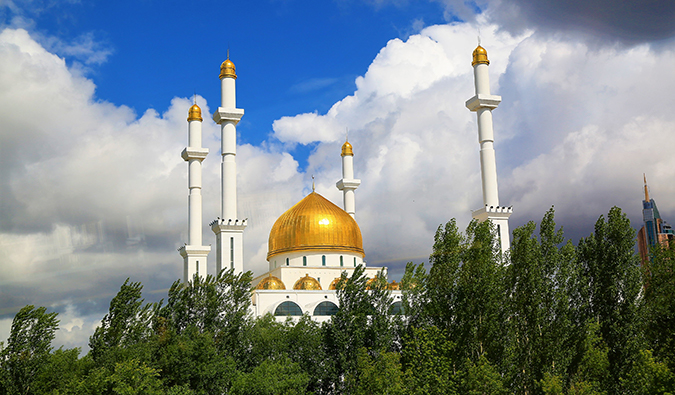 Posted: 11/18/19 | November 18th, 2019
Kazakhstan is a country I’ve always wanted to visit. In fact, I’ve always wanted to go to all the “Stans”. It’s the region of the world I probably want to visit the most. After having lived in Kazakhstan for 8 years, Doug Fears knows a thing or two about the country and how to navigate it. In this guest post, Doug offers some in-depth advice about how to travel around Kazakhstan by train!
Night spilled across the Kazakh steppe. The train’s steel wheels clickety-clacked below, gently prompting me to point toward a bowl of plastic-wrapped apples. Suddenly, my drunken dining car companion began gesticulating wildly while repeating his favorite, and perhaps only, English-language phrase, “No problem!” With a shake of the head and wave of the hand, this newfound friend seemed to dismiss all other apples as second-rate. Apples originated from Kazakhstan, after all, and we had just departed the city of Almaty, “the father of apples.” I simply had to try one. (It was delicious.)
Taking the train through Kazakhstan, the world’s ninth largest country, presents a changing cultural tapestry every time. Imagine a vast land, once secretive and closed to outsiders, where travelers can now experience an eclectic blend of Silk Road culture, offbeat Soviet-era history, and wide-open spaces spiced with warm Kazakh hospitality.
I’ve shared cabins with young soldiers, border police, language professors and martial artists, just to name a few. My favorite memories are the meals and card games enjoyed with these folks, even when I didn’t have a common language.
So forget everything about the movie Borat, and climb aboard as you browse ancient bazaars, ride the rails, and trek to pristine mountain lakes.
Posted: 11/18/19 | November 18th, 2019
Kazakhstan is a country I’ve always wanted to visit. In fact, I’ve always wanted to go to all the “Stans”. It’s the region of the world I probably want to visit the most. After having lived in Kazakhstan for 8 years, Doug Fears knows a thing or two about the country and how to navigate it. In this guest post, Doug offers some in-depth advice about how to travel around Kazakhstan by train!
Night spilled across the Kazakh steppe. The train’s steel wheels clickety-clacked below, gently prompting me to point toward a bowl of plastic-wrapped apples. Suddenly, my drunken dining car companion began gesticulating wildly while repeating his favorite, and perhaps only, English-language phrase, “No problem!” With a shake of the head and wave of the hand, this newfound friend seemed to dismiss all other apples as second-rate. Apples originated from Kazakhstan, after all, and we had just departed the city of Almaty, “the father of apples.” I simply had to try one. (It was delicious.)
Taking the train through Kazakhstan, the world’s ninth largest country, presents a changing cultural tapestry every time. Imagine a vast land, once secretive and closed to outsiders, where travelers can now experience an eclectic blend of Silk Road culture, offbeat Soviet-era history, and wide-open spaces spiced with warm Kazakh hospitality.
I’ve shared cabins with young soldiers, border police, language professors and martial artists, just to name a few. My favorite memories are the meals and card games enjoyed with these folks, even when I didn’t have a common language.
So forget everything about the movie Borat, and climb aboard as you browse ancient bazaars, ride the rails, and trek to pristine mountain lakes.
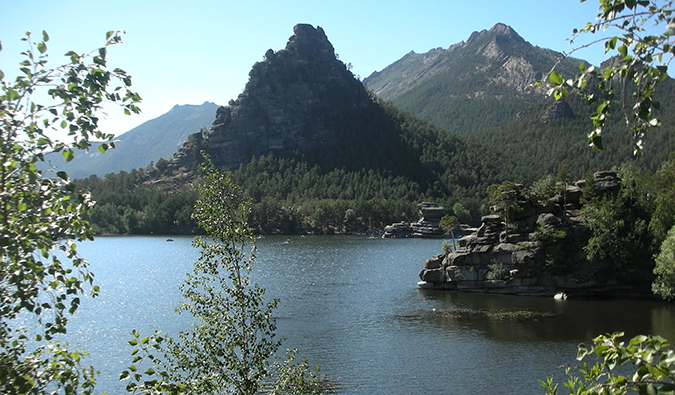 I suggest the following itinerary: flying into the capital, Nur-Sultan (formerly Astana) (airport code TSE), heading north to nearby Lake Burabay, taking a fast train back south to Karaganda, then an overnight classic train to Almaty in the southeast, with a possible extension to Turkistan (a city and region in the south of the country).
If you want to continue on in Central Asia, you can easily extend your trip from Almaty to see the gorgeous mountain vistas of nearby Kyrgyzstan or continue by train from Turkistan south to Uzbekistan.
The best time to go is between May and October, as northern Kazakhstan is blanketed in snow from November through April, with typical temps in the minus-20 range. Those wanting to snow ski or experience the excitement of New Year’s, the country’s biggest holiday, however, should consider a wintertime trip.
Visas are no longer needed for most visitors to Kazakhstan (for 30 days) and Kyrgyzstan (for 60 days), though advance visas are required for Uzbekistan, Russia, and China.
I suggest the following itinerary: flying into the capital, Nur-Sultan (formerly Astana) (airport code TSE), heading north to nearby Lake Burabay, taking a fast train back south to Karaganda, then an overnight classic train to Almaty in the southeast, with a possible extension to Turkistan (a city and region in the south of the country).
If you want to continue on in Central Asia, you can easily extend your trip from Almaty to see the gorgeous mountain vistas of nearby Kyrgyzstan or continue by train from Turkistan south to Uzbekistan.
The best time to go is between May and October, as northern Kazakhstan is blanketed in snow from November through April, with typical temps in the minus-20 range. Those wanting to snow ski or experience the excitement of New Year’s, the country’s biggest holiday, however, should consider a wintertime trip.
Visas are no longer needed for most visitors to Kazakhstan (for 30 days) and Kyrgyzstan (for 60 days), though advance visas are required for Uzbekistan, Russia, and China.
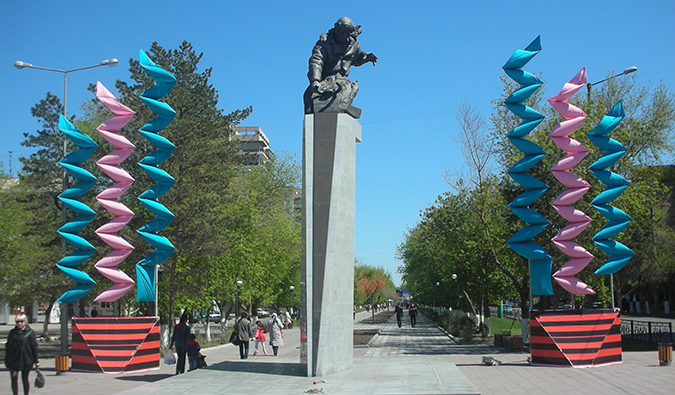 There are three types of trains: the fast business-class Talgo, regular long-distance trains, and regional electrics. Budget travelers should opt for regular trains for most trips. Regional electrics are generally slow and will be of limited use.
On regular trains — highly recommended for the best cultural experience — the two main classes are kupe (a four-person closed compartment with two upper and lower bunks) and platzkar (an open rolling dormitory holding 54 travelers on two-level bunks). The kupe is quieter and more private, but single women might want to choose the somewhat safer open platzkar, as they could be in a locked cabin with three men (no gender distinctions are made when making reservations). Also realize that not all trains run daily.
The new
There are three types of trains: the fast business-class Talgo, regular long-distance trains, and regional electrics. Budget travelers should opt for regular trains for most trips. Regional electrics are generally slow and will be of limited use.
On regular trains — highly recommended for the best cultural experience — the two main classes are kupe (a four-person closed compartment with two upper and lower bunks) and platzkar (an open rolling dormitory holding 54 travelers on two-level bunks). The kupe is quieter and more private, but single women might want to choose the somewhat safer open platzkar, as they could be in a locked cabin with three men (no gender distinctions are made when making reservations). Also realize that not all trains run daily.
The new 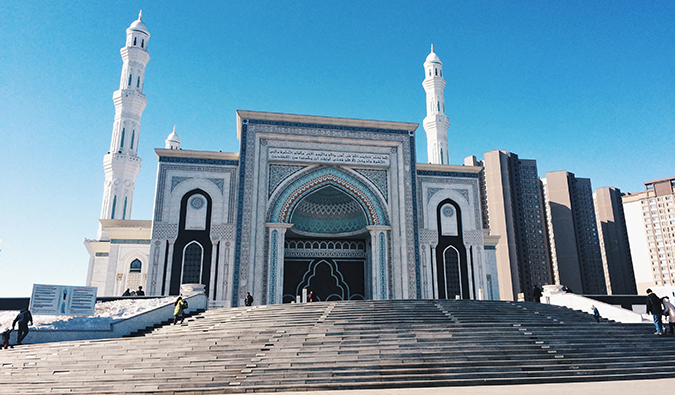 Traveling by train is much safer and enjoyable than by bus, and an incredible value for the long distances traveled. A standard overnight train ticket from Karaganda to Almaty will be about $9 USD for platzkar and $14 for kupe. By comparison, the business-class Talgo on the same route costs $25 in a four-berth kupe, but it does reduce travel time by six hours (and has much cleaner bathrooms!). A night train provides double value, serving as both bed and transport; they are cooler and more comfortable in the summer travel season too!
Local city buses are cheap, about $0.20 per ride, regardless of distance.
Hotel rooms in the city centers of Nur-Sultan and Almaty range from $30 to $50 per night with breakfast. Full apartments ($25/night) or shared guest rooms ($10/night) can be booked on
Traveling by train is much safer and enjoyable than by bus, and an incredible value for the long distances traveled. A standard overnight train ticket from Karaganda to Almaty will be about $9 USD for platzkar and $14 for kupe. By comparison, the business-class Talgo on the same route costs $25 in a four-berth kupe, but it does reduce travel time by six hours (and has much cleaner bathrooms!). A night train provides double value, serving as both bed and transport; they are cooler and more comfortable in the summer travel season too!
Local city buses are cheap, about $0.20 per ride, regardless of distance.
Hotel rooms in the city centers of Nur-Sultan and Almaty range from $30 to $50 per night with breakfast. Full apartments ($25/night) or shared guest rooms ($10/night) can be booked on 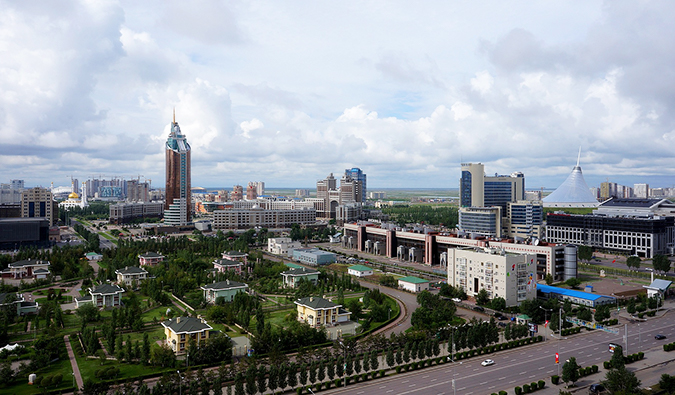
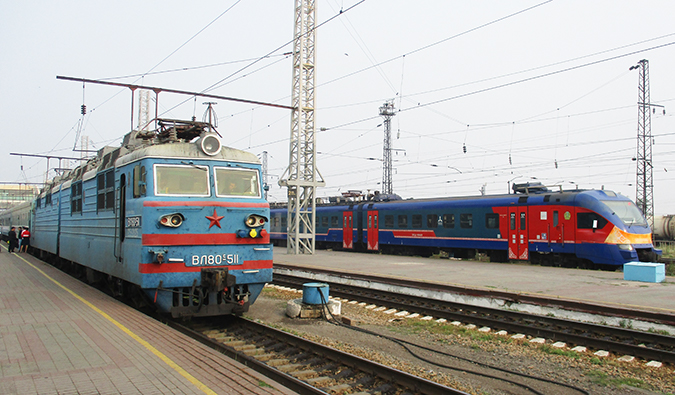 Because of the challenges with the ticketing website, I’ve listed the most helpful train routes for getting around. Note that all of these run daily.
While northbound trains from Nur-Sultan stop at Borovoye/Shchuchinsk, it might be easier to take a shared van or minibus for the short 2.5-hour trip. Just listen or ask for “Borovoye” at the Nur-Sultan-1 train station, where vans wait to fill up and leave throughout the day. You can do the same if heading directly south from Nur-Sultan to Karaganda, as a new tollway has opened, cutting the travel time between these two major cities to two hours, although all Nur-Sultan-to-Almaty trains also stop there. Note that both Nur-Sultan and Almaty have two train stations in different parts of the city — make sure you go to the right one!
Train #031 from Almaty to Semey in the northeast traces the historical “TurkSib” route — from here you can head east to explore the Altay Mountains or continue north into Russia to connect with the legendary Trans-Siberian route.
Because of the challenges with the ticketing website, I’ve listed the most helpful train routes for getting around. Note that all of these run daily.
While northbound trains from Nur-Sultan stop at Borovoye/Shchuchinsk, it might be easier to take a shared van or minibus for the short 2.5-hour trip. Just listen or ask for “Borovoye” at the Nur-Sultan-1 train station, where vans wait to fill up and leave throughout the day. You can do the same if heading directly south from Nur-Sultan to Karaganda, as a new tollway has opened, cutting the travel time between these two major cities to two hours, although all Nur-Sultan-to-Almaty trains also stop there. Note that both Nur-Sultan and Almaty have two train stations in different parts of the city — make sure you go to the right one!
Train #031 from Almaty to Semey in the northeast traces the historical “TurkSib” route — from here you can head east to explore the Altay Mountains or continue north into Russia to connect with the legendary Trans-Siberian route.
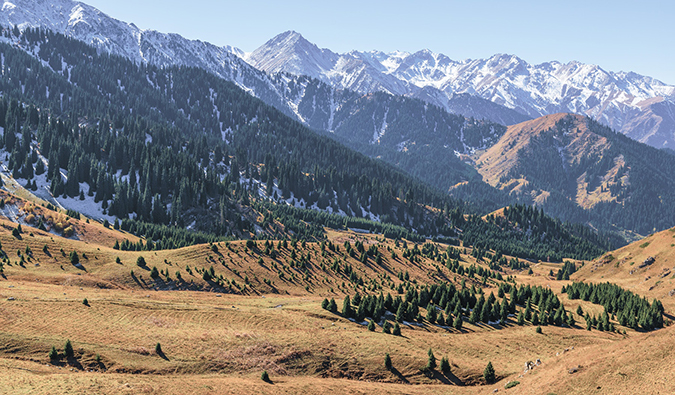 The major cities of Nur-Sultan, Karaganda, and Almaty are all on the main rail line and make both good stopovers and bases for exploring the surrounding natural and historical sites. Other off-the-beaten-track locations, such as the Baykonur rocket base and Altay Mountains, require special permission and advance planning. Here’s an overview of the major destinations:
The major cities of Nur-Sultan, Karaganda, and Almaty are all on the main rail line and make both good stopovers and bases for exploring the surrounding natural and historical sites. Other off-the-beaten-track locations, such as the Baykonur rocket base and Altay Mountains, require special permission and advance planning. Here’s an overview of the major destinations:
 Posted: 11/16/19 | November 16th, 2019
One of the best parts about running a business is the cool business travel credit cards you get access to. These cards tend to have a lot better points-earning abilities and perks than consumer cards. I’ve been running this website for eleven years and have tried a lot of cards during that time.
I’m often asked by other bloggers, creators, and entrepenuers which
Posted: 11/16/19 | November 16th, 2019
One of the best parts about running a business is the cool business travel credit cards you get access to. These cards tend to have a lot better points-earning abilities and perks than consumer cards. I’ve been running this website for eleven years and have tried a lot of cards during that time.
I’m often asked by other bloggers, creators, and entrepenuers which 